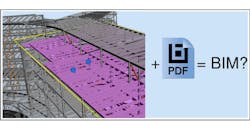The great debate: Is 3D PDF really BIM?
There’s a debate brewing in conversations surrounding BIM. It typically comes up when the discussion turns to ways to share model information with other project partners, especially trade partners or inter-disciplinary project partners. For most designers and virtual design and construction or VDC teams, navigating, collaborating and sharing model-centric data isn’t that big of a challenge.
But for those project partners outside of these circles, a breakdown tends to occur. One way to solve this breakdown is by leveraging PDF—specifically, 3D PDFs. With 3D PDFs, you’re able to share parts and components of the model without needing special software, or complicated workflows. You can pull apart buildings, cut through floors, and view simulated animation for assembly instructions—all within a PDF. You can even comment and markup these PDFs, asking clarifying questions or providing additional instructions.
However, it is here where a debate begins. The question is asked, “If discussions are occurring outside of the model, is it still BIM?” My response is typically, “Well, what is the alternative?” Or more importantly, “What is the intention of BIM in the first place?” Isn’t the goal of BIM to tie together information created, distributed and gathered during the project lifecycle? Aren’t we all striving to remove process inefficiencies, changing the way project teams create, share and consume information?
This is usually where the debate goes one of two ways – it either sparks a lively conversation about the real-life challenges facing the AEC industry and the solutions beginning to bridge the BIM gap, or it turns into a lecture on the lack of progress due to industry laggards, who are stubborn in their ways. Either way, a conversation is taking place, which I believe is relevant to the industry today and necessary for those outside of the BIM conversation to even take notice and care.
Admittedly, I tend to argue pretty fiercely for the trade partner in this debate. In full disclosure, I spent the first five years of my career in the AEC industry, working for a small but reputable Herman Miller contract furniture dealer. Some would consider these humble beginnings, but I would argue it was the perfect place to start my career. I consider it now the boot camp experience of AEC. I gained valuable firsthand experience with the trade partner’s perspective, and the very real challenges they face. During this time, I was taken under the wing of an industry veteran who taught me some valuable lessons that I still hold to this day. Lessons like the golden rule of CYA and to always have a good roll of blue tape in your car, as well as a tape measure. Another valuable lesson she taught me: always communicate clearly. When creating installation drawings, always put yourself in the shoes of the person you’re creating drawings for. Markup your drawings to answer their questions so they don’t have to ask – it saves you both valuable time.
This fundamental lesson seems to gets lost in our haste to push the industry forward. If the goal is to communicate clearly, leveraging rich data represented by a 3D model, wouldn’t we be reaching this goal if we were able to get all trade partners on board, even if it’s using a 3D PDF? Is it not progress to bridge the gap between the BIM haves and have-nots? And those who argue that PDF is nothing but digital paper may need to rethink that statement with the recent advancements in 3D PDF technology.
So now I ask you, what do you think of this debate? On which side do you fall? Is there something missing from 3D PDF as it exists today that is holding back the flow of information? Please share your thoughts…it’s a great conversation I hope we can continue to have.
About the Author

Sasha Reed
As Vice President of Strategic Development at Bluebeam, Inc., Sasha Reed collaborates with leaders in the architecture, engineering and construction industry to guide Bluebeam’s technology, partnerships and long-term goals. She joined Bluebeam in 2007 and co-created the Concierge Approach, a distinctly branded process of customer engagement, product feedback and solution delivery to which much of Bluebeam’s success is attributed, and which today is replicated at every organizational level.
Sasha is known industry-wide as a “conversation facilitator,” creating platforms for exchanges necessary to digitally advance the industry, including the BD+C Magazine Digital COM Blog, which she authors and manages. She’s been a featured presenter at numerous national and international conferences, including the 2014 Design-Build Institute of America (DBIA), Federal Project Delivery Symposium and NTI Danish BIM Conference. Sasha also co-chairs the Construction PDF Coalition, a grassroots effort to provide a common industry framework from which to create and maintain construction PDF documents, serves on the City College of San Francisco BIM Industry Council, and is Advisor to the Board of Direction for the National Institute of Building Sciences BuildingSMART Alliance.
